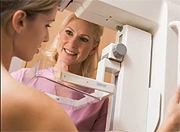
TUESDAY, Nov. 27 (HealthDay News) — The contentious U.S. guidelines that recommend fewer mammograms for most women could lead to lower screening rates and a dip in breast cancer detection, two new studies suggest.
In 2009, the U.S. Preventive Services Task Force — an independent medical panel with federal support — ignited a controversy when it recommended against routine mammography screening for most women in their 40s and advised less frequent screening for older women.
Instead, the task force said, women in their 40s can discuss mammography screening with their doctors, but should not automatically have it done. For women aged 50 to 74, the panel suggested a mammogram every two years. And for those age 75 and up, the group said there’s too little evidence to recommend for or against screening.
That’s out of step with advice from other groups, such as the American Cancer Society and the American College of Obstetricians and Gynecologists. They urge women to get yearly mammograms starting at age 40.
The two new studies, to be presented Tuesday at the annual meeting of the Radiological Society of North America in Chicago, tried to look at the potential impact of the task force guidelines.
In one, researchers compared mammography screening rates among women on Medicare before and after the 2009 recommendations. They found that the rate inched up by about 1 percent between 2005 and 2009, with almost one-third of women having a mammogram in 2009.
But in 2010, the screening rate dropped to just under 31 percent — a decline of 4.3 percent over one year.
The findings do not prove that the task force guidelines were the cause, but lead researcher Dr. David Levin said he thinks the pattern is clear.
“Up until 2009, the mammography rate was going up slowly. In 2010, there was an abrupt drop. It seems pretty obvious that [the guidelines] were the cause,” said Levin, chairman emeritus of radiology at Thomas Jefferson University Hospital in Philadelphia.
All of the women in the study were on Medicare, which covers Americans aged 65 and up. Levin said the mammography rate could have declined in 2010 because some women were waiting an extra year between mammograms.
“Or some women older than 74 may have dropped out of screening altogether,” he added.
And what would be wrong with that, if that’s the task force guideline? Levin said he thinks women should stick with the traditional advice of the American Cancer Society and other groups. “I think it’s a shame that there’s now a recommendation discouraging some women from getting screened,” he said.
Dr. Elizabeth Arleo, one of the researchers on the second study, agreed.
Her team looked at more than 43,000 screening mammograms done at New York-Presbyterian/Weill Cornell Medical Center between 2007 and 2010. Overall, there were 4.7 cancers caught for every 1,000 mammograms; the rate among women in their 40s was lower — at 2.7 per 1,000.
But women in their 40s accounted for almost 20 percent of all breast cancers.
“It seems unacceptable to potentially miss 20 percent of the breast cancers we are identifying,” said Arleo, an assistant professor of radiology at the medical center.
Her study did not, however, look at a woman’s risk of dying from breast cancer. It’s not clear whether patients in their 40s would have had a greater death risk had their tumors been detected later — either after a woman found a lump, or through a mammogram done at age 50.
But Arleo noted that even the task force said that for women in their 40s, mammograms are linked to a 15 percent reduction in the risk of dying from breast cancer.
The problem, the panel said, is that for women younger than 50, the benefits of mammograms may not outweigh the risks. Those include “false-positive” results that lead to needless invasive tests and anxiety (which are more common in women younger than 50), and overtreatment of early breast tumors that would never have progressed.
In Arleo’s study, just over half of women in their 40s diagnosed with breast cancer — 21 of 39 — had tumors that had invaded the breast tissue. The rest had ductal carcinoma in situ (DCIS), which refers to abnormal cells in the milk ducts that may or may not progress to invasive cancer.
Right now, doctors have no way of predicting which cases of DCIS will progress. So women usually receive treatment — which may mean surgery to remove some breast tissue or the whole breast. And that’s raised concerns about overtreatment.
Because the two new studies were presented at a meeting, the findings should be considered preliminary until they have been published in a peer-reviewed medical journal.
They were also conducted by radiologists — the specialists who do all those mammograms. But an expert who is not a radiologist and not connected to the research agreed that the findings support advice for women to begin mammograms at age 40.
“I think this reinforces concerns a lot of us have had since the [USPSTF] guidelines came out,” said Dr. Therese Bevers, a professor of clinical cancer prevention at the University of Texas M.D. Anderson Cancer Center in Houston.
“There are harms from screening, and I think that’s something everyone in this field recognizes,” Bevers said.
But she thinks the benefits outweigh the downsides, and she also noted that the task force suggests that screening decisions be individualized for women in their 40s, taking into account their risk factors.
However, researchers are still trying to figure out what the risk factors are. Strong family history is one; but in Arleo’s study, Bevers noted, only three of the 39 breast cancer patients in their 40s had a mother or sister diagnosed with early breast cancer.
“Until we have a better understanding of how to target screening to certain women in their 40s, I think we should screen everyone,” Bevers said.
According to the U.S. National Cancer Institute, the average 40-year-old woman has a one in 69 chance of developing breast cancer in the next 10 years. A 60-year-old woman has a one in 29 chance.
More information
Learn more about breast cancer and mammograms from the U.S. National Cancer Institute.

